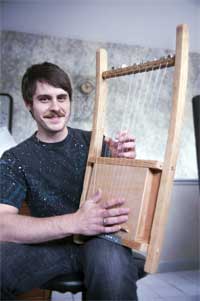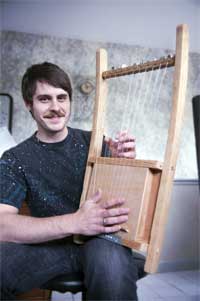 KINGSTON, R.I. – May 29, 2012 – Steve Craveiro initially hoped his passion for music would lead him to a successful performance career, but instead it has led him down a completely different path, one that found him building an ancient instrument that Emperor Nero famously played as Rome burned in the first century.
KINGSTON, R.I. – May 29, 2012 – Steve Craveiro initially hoped his passion for music would lead him to a successful performance career, but instead it has led him down a completely different path, one that found him building an ancient instrument that Emperor Nero famously played as Rome burned in the first century.
The University of Rhode Island senior has become somewhat of an expert on the cithara, and with his father’s help, he even built one by hand in the way the Romans would have.
“I started playing guitar when I was 12, and I worked for a while in California doing session work, but it was more of a business there and not the passion that I loved,” said Craveiro, a resident of Lincoln. “So I enrolled at URI for a degree in history, my second passion.”
Bridget Buxton, URI assistant professor of history, encouraged Craveiro to combine his interests for an independent study project by researching a historic instrument. Together they identified the cithara as an instrument that deserved new attention.
“This was the virtuoso’s instrument, the rock star guitarist’s instrument of the time,” Craveiro said. “It was looked down upon by the elders and the elites as a perversion of an ancient art, sort of like rock music was not too long ago. But it appealed to the masses.”
The 11-string instrument resembles a lyre and can be strummed like a guitar or plucked like a harp. When Buxton suggested he build one, Craveiro was uncertain he had the skills to do so.
“My father has an auto body shop, and I have some experience there working with my hands, but not building something from scratch,” he said. “It wasn’t so much the building of it that I was worried about, it was conceptualizing how to do it.”
According to Craveiro, in Roman times the instrument was built from parts from old furniture. When his father came home with an antique hickory chair, Craveiro knew it would be the basis of his cithara.
The back of the chair became the instrument’s frame, and its legs were incorporated into the design as well. The sound box is a cigar box made of mahogany, a wood that Craveiro said is often used to build acoustic guitars. The addition of tuning pegs and nylon strings from some of his old guitars completed the job.
Buxton was so pleased with the finished product that she invited Craveiro to play it in one of her history classes on the last day of the semester.
“Steve is a talented musician, and he produced an excellent paper about the cithara,” said Buxton. “He has even tuned it to the same chord structure that the ancients used. The instrument is a gorgeous piece of craftsmanship and the result of some very sophisticated research.”
When asked what his next step is, Craveiro was uncertain.
“I’m still absorbing the fact that I made it,” he said. “I didn’t know if I was cut out for this kind of directed study. I had a lot of anxiety about it, but I feel good about it now and want to learn more. It really showed me what I’m capable of.”
With a few more classes to complete before he graduates, Craveiro thinks he may want to pursue graduate school to continue his studies of ancient instruments, though he has other ideas percolating in his head as well.
“This thing started out as an academic exercise, but when it started coming to fruition, it became much more than that,” he said. “I wanted to make it a playable instrument. We’ll just have to wait and see where else it takes me.”

